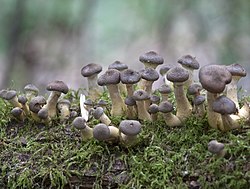| Armillaria cepistipes | |
|---|---|
 | |
| Scientific classification | |
| Domain: | Eukaryota |
| Kingdom: | Fungi |
| Division: | Basidiomycota |
| Class: | Agaricomycetes |
| Order: | Agaricales |
| Family: | Physalacriaceae |
| Genus: | Armillaria |
| Species: | A. cepistipes |
| Binomial name | |
| Armillaria cepistipes Velen. (1920) | |
| Synonyms | |
Armillaria cepistipes is a common wood-rotting basidiomycete fungus found in most forests in Central Europe. [3] Armillaria cepistipes is a species of mushroom in the family Physalacriaceae. This is a weakly plant pathogenic species that is typically found growing at the base of deciduous trees that have previously been stressed by another pathogen. [4] The mycelium of the fungus is bioluminescent. [5]